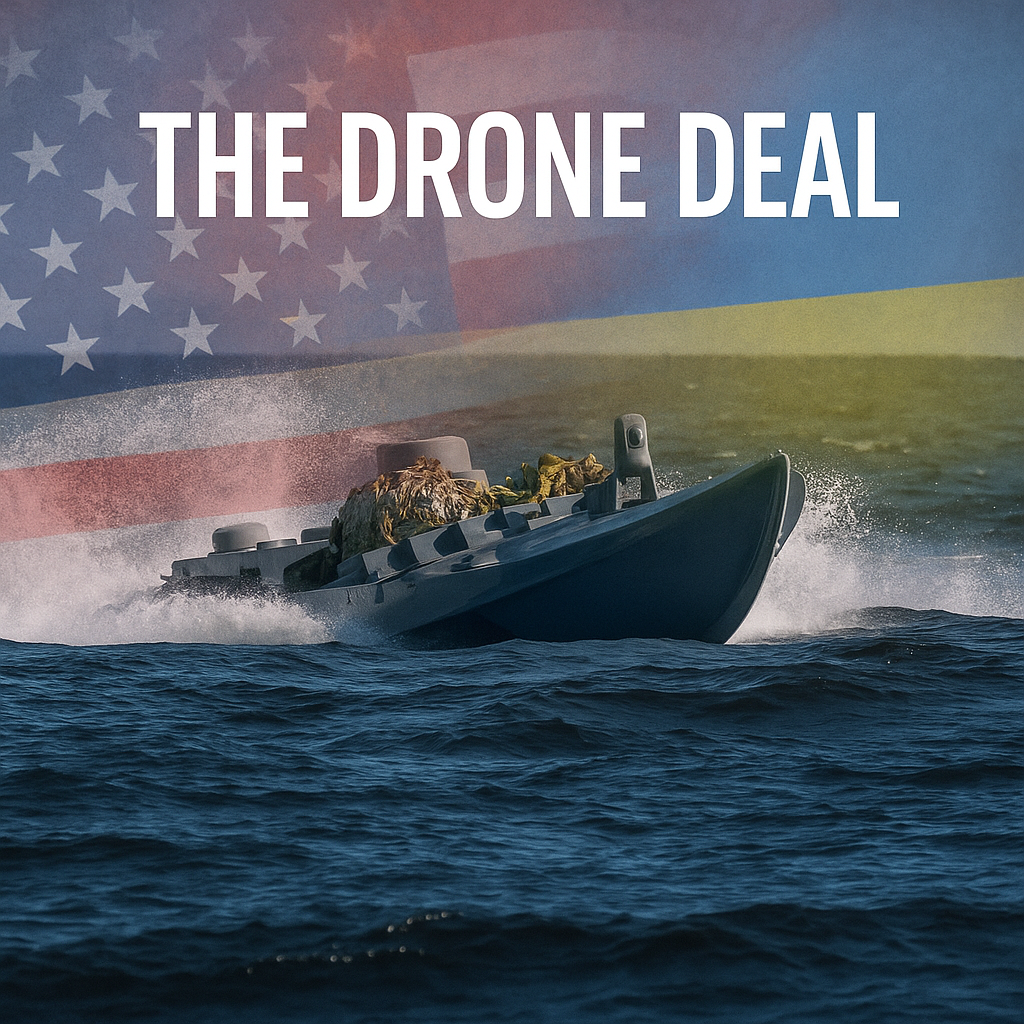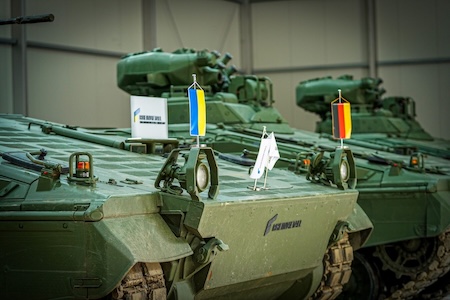18 July 2025 – A potential landmark agreement is taking shape that could fundamentally redefine the U.S.-Ukraine relationship and the future of modern warfare. Following reports of a new framework for security assistance, this analysis examines the powerful strategic convergence between Ukraine's revolutionary drone warfare ecosystem and the "America First" foreign policy of the current U.S. administration.
The proposed deal, centred on providing Ukraine with high-end U.S. weaponry in exchange for unprecedented access to its battle-proven drone technology, is far more than a simple transaction. It represents a confluence of interests where Ukrainian military innovation provides a compelling solution to the core political, economic, and strategic dilemmas of its most important partner. To understand the logic of this deal, one must first grasp the true value of the asset Ukraine brings to the table: not just hardware, but a complete, combat-proven ecosystem for 21st-century warfare.
The Asset: Ukraine’s Multi-Domain Drone Revolution
The conflict in Ukraine is widely recognised as the world's first true drone war, a crucible in which Ukraine has emerged as a preeminent innovator. Its drone capability is not a single piece of hardware but a comprehensive ecosystem encompassing technology, doctrine, and a hyper-agile industrial model that has systematically blunted the advantages of a superior conventional military. This ecosystem is the core asset in any strategic transaction.
A Multi-Domain Unmanned Force:
Ukraine's drone arsenal is a sophisticated, multi-layered force spanning air, sea, and land.
Aerial Drones: The skies over Ukraine are dominated by a diverse fleet of UAVs.
- First-Person View (FPV) Drones: These low-cost workhorses, estimated at around $400 per unit, are believed to be responsible for the vast majority of Russian casualties. Evolving from small 7-inch models to larger, more robust 13-inch platforms, they have become universal tools for bombing, reconnaissance, and creating a staggering economic asymmetry against multi-million-dollar armoured vehicles.
- Long-Range Attack Drones: Ukraine has developed a formidable class of one-way attack (OWA) drones like the "Lyutyy" (Fierce), "Bober" (Beaver), and AQ-400 "Scythe". With ranges exceeding 1,000 km, these systems have been used in audacious strikes against high-value strategic targets deep inside Russia, providing a deterrent that partially compensates for a deficit in long-range missiles.
- Interceptor Drones: In a mature display of two-sided drone warfare, Ukraine has developed specialised interceptors like the "Sting" quadcopter to counter Russian drones. At a cost of around $5,000 per unit, these provide a cost-effective alternative to using multi-million-dollar air defence missiles against cheap threats.
- "Mothership" Drones: In a remarkable tactical innovation, larger fixed-wing UAVs act as motherships, carrying and deploying up to six smaller FPV drones up to 70 km behind enemy lines, enabling coordinated swarm-like attacks.
Naval Drones (USVs): Lacking a conventional navy, Ukraine built a "technological navy" from scratch, centred on unmanned surface vessels that have altered the balance of power in the Black Sea.
- Kamikaze platforms like the "Sea Baby" and "Magura V5" are credited with sinking or damaging around one-third of Russia's Black Sea Fleet, forcing its retreat from occupied Crimea.
- These USVs have since evolved into multi-mission platforms, serving as mobile launch pads for aerial drones and, in a world-first, as anti-aircraft platforms armed with missiles like the R-73 and AIM-9X Sidewinder.
Unmanned Ground Vehicles (UGVs): To reduce risk to human life, Ukraine is making significant strides in UGVs for logistics, medical evacuation, and combat engineering roles like offensive mining and demining.
The Business Case: Disruptive Economics and Scalable Production
For an administration focused on transactional value, the most compelling aspect of Ukraine's drone revolution is its profound economic logic. It offers a paradigm-shifting model that directly addresses the unsustainable cost structures plaguing Western defence establishments, reframing support from aid to a high-return strategic investment.
Unprecedented Cost-Effectiveness: The core business case is the staggering cost asymmetry where inexpensive, disposable systems neutralise assets orders of magnitude more expensive. The use of a $400 FPV drone to destroy a multi-million-dollar tank creates a devastatingly unfavourable exchange ratio for the adversary. This model stands in stark contrast to the Western approach of "shooting million-dollar missiles at $50,000 Russian drones," an economically losing proposition. Ukrainian interceptor drones, at ~$5,000, offer a direct solution.
Scalability and Export Potential: Ukraine has built a resilient, decentralised industrial base capable of mass production, transforming its technology from a battlefield asset into a global commodity. By early 2025, Ukraine was reportedly manufacturing 200,000 FPV drones per month, with a total 2024 production estimated at approximately 2 million units. This industrial capacity positions Ukraine as an emerging "drone superpower," with one lawmaker estimating a potential $20 billion in export revenue. For the U.S., this means a partnership would be for a mature, mass-producible product line, not a boutique prototype.
This economic logic aligns perfectly with the "business for us" framework articulated by the administration, where military support is structured as a profitable industrial partnership.
The Political Alignment: Solving "America First" Dilemmas
A partnership centred on Ukrainian drone technology offers a powerful solution to several of the administration's core political and strategic challenges, allowing it to advance the "America First" agenda in a tangible and marketable way.
Enforcing Burden-Sharing: A central theme of the administration's foreign policy has been the demand that NATO allies "pay up" and meet defence spending targets. Ukrainian drone technology provides the perfect capability for allies to spend their increased budgets on. The U.S. could license the technology, manufacture the drones domestically, and sell them to European partners, who would then be fulfilling their spending commitments by purchasing American-made systems to arm Ukraine and bolster their own defences. This allows the administration to claim a victory in forcing allies to pay their share.
Projecting Strength Without "Endless" Commitments: The deal masterfully resolves the tension between supporting Ukraine and the promise to end "endless wars" and open-ended aid packages. It is a force multiplier that empowers Ukraine to become more self-sufficient. Crucially, a technology transfer is a finite, transactional acquisition, not a perpetual handout. The narrative shifts from "we are giving Ukraine money" to "we are buying Ukraine's world-class technology," a politically potent message for a voter base opposed to unconditional foreign aid.
Securing a Tangible "Win" for America: The acquisition of a dominant, "best in the world" technology is a clear and communicable victory. It reframes the U.S.-Ukraine relationship from one of dependency to a strategic partnership where Ukraine provides critical, cutting-edge technology that directly benefits the United States, making its soldiers safer and more lethal.
The Pentagon Corrective: Leapfrogging Bureaucratic Inertia
A strategic partnership offers more than just new hardware; it offers a profound corrective to the U.S. military's slow and bureaucratic procurement system. Ukraine’s innovation ecosystem, which is agile, responsive, and battle-tested, is a ready-made alternative that aligns with the administration's stated goals.
The June 2025 Executive Order on "Unleashing American Drone Dominance" already directs the Department of Defense to prioritise "low-cost, high-performing drones". A deal with Ukraine provides a dramatic shortcut to implementing this policy. While elite U.S. units in 2025 were just beginning to establish labs for FPV drones, Ukraine has been mastering their use for years, highlighting a significant capability gap the U.S. could close almost overnight.
By acquiring Ukraine's proven technology and, just as importantly, its agile innovation process, the U.S. can bypass the high-risk, expensive R&D phases and immediately begin producing systems known to be effective against a peer adversary.
The Geopolitical Calculus: Countering China and Reasserting Leadership
The deal carries significant weight in the arena of great-power competition.
Countering the China-Russia Axis: Drone warfare is a central pillar of Chinese and Russian military modernisation programmes. A U.S.-Ukraine alliance would leverage an asymmetric advantage its competitors lack: extensive, real-world combat experience in a high-intensity drone war. While China develops its systems in controlled tests, the U.S. would acquire technology brutally tested and validated daily on the battlefield, securing a Western lead in low-cost, resilient drone warfare.
Reasserting U.S. Leadership: By introducing Ukraine’s proven, cost-effective solutions into the transatlantic fold, the United States can demonstrate a new and more effective form of leadership within NATO, one based on practical, results-oriented, and fiscally responsible innovation.
A New Foreign Policy Template: The drone deal would not exist in isolation. It would form a parallel pillar to the 2025 U.S.-Ukraine strategic minerals agreement. Together, they create a comprehensive strategic compact: one pillar secures the raw materials for 21st-century industry, and the other secures the military technology for 21st-century warfare. This model, which links security assistance to the acquisition of tangible assets, is the epitome of the administration's transactional diplomacy and could become a replicable template for future alliances.
Conclusion: The Inevitable Logic of a Transformative Deal
The potential for a "mega deal" centred on Ukrainian drone technology is driven by a powerful confluence of economic, political, and military-industrial advantages. It offers a rare opportunity to transform the perceived liability of supporting Ukraine into a decisive strategic victory that strengthens American industry, enhances military dominance, enforces burden-sharing among allies, and provides a powerful counter to China and Russia. It is the quintessential embodiment of a transactional, "America First" foreign policy, making it a uniquely compelling and logical path forward.

.svg)


